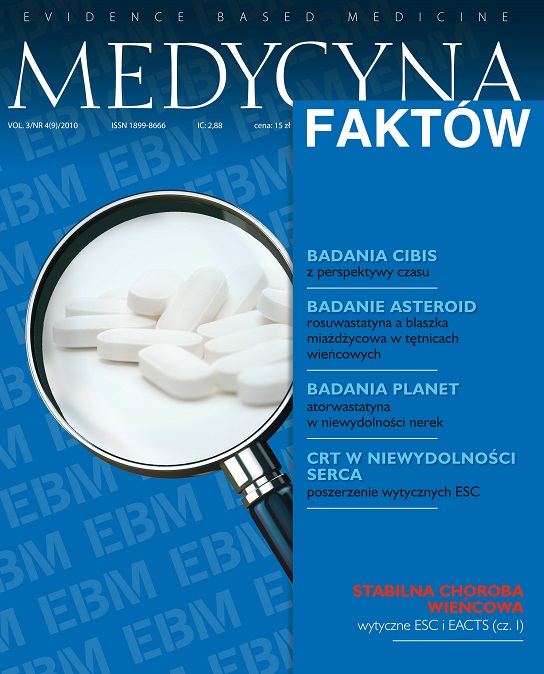Nowe standardy dotyczące CRT w niewydolności serca NYHA I–II Artykuł przeglądowy
##plugins.themes.bootstrap3.article.main##
Abstrakt
Niewydolność serca (HF) jest obecnie jedną z najważniejszych chorób układu krążenia i z uwagi na częstość występowania, złe rokowanie oraz wysokie koszty terapii stanowi coraz poważniejszy problem medyczny. Zgodnie z wynikami dużych, randomizowanych badań klinicznych, w których udowodniono, że terapia resynchronizująca (CRT) wpływa korzystnie na regresję objawów HF oraz poprawia przeżycie w grupie pacjentów z HF, dotychczas rekomendowano implantację CRT u chorych w III i IV klasie NYHA, z frakcją wyrzutową lewej komory ≤35% i szerokością zespołów QRS ≥120 ms. Po przedstawieniu w 2009 r. wyników dwóch dużych badań klinicznych: MADIT-CRT i REVERSE, do których włączano pacjentów bez objawów lub z łagodnie nasilonymi objawami HF, na tegorocznym Kongresie Europejskiego Towarzystwa Kardiologicznego w Sztokholmie przedstawiono najnowsze wytyczne dotyczące wskazań do implantacji CRT, wg których wszczepienie CRT jest obecnie również wskazane u chorych w II klasie wg NYHA, z EF ≤35% i szerokością zespołów QRS ≥150 ms.
##plugins.themes.bootstrap3.article.details##
Copyright © by Medical Education. All rights reserved.
Bibliografia
2. Dickstein K., Vardas P.E., Auricchio A. et al.: 2010 Focused update of ESC guidelines on device therapy in heart failure. An update of the 2008 ESC guidelines for the diagnosis and treatment of acute and chronic heart failure and the 2007 ESC guidelines for cardiac and resynchronization therapy. Developed with the special contribution of the Heart Failure Association and the European Heart Rhythm Association. Eur. Heart J. 2010 [online: DOI:10.1093/eurheartj/ehq337].
3. Linde C., Abraham W.T., Gold M.R. et al.: Randomized trial of cardiac resynchronization in mildly symptomatic heart failure patients and in asymptomatic patients with left ventricular dysfunction and previous heart failure symptoms. J. Am. Coll. Cardiol. 2008; 52: 1834-1843.
4. Daubert C., Gold M.R., Abraham W.T. et al.: Prevention of disease progression by cardiac resynchronization therapy in patients with asymptomatic or mildly symptomatic left ventricular dysfunction: insights from the European cohort of the REVERSE (Resynchronization Reverses Remodeling in Systolic Left Ventricular Dysfunction) trial. J. Am. Coll. Cardiol. 2009; 54: 1837-1846.
5. Moss A.J., Hall W.J., Cannom D.S. et al.: Cardiac-resynchronization therapy for the prevention of heart-failure events. N. Engl. J. Med. 2009; 361: 1329-1338.
6. Abraham W.T., Fisher W.G., Smith A.L. et al.: Cardiac resynchronization in chronic heart failure. N. Engl. J. Med. 2002; 346: 1845-1853.
7. Young J.B., Abraham W.T., Smith A.L. et al.: Combined cardiac resynchronization and implantable cardioversion defibrillation in advanced chronic heart failure: the MIRACLE ICD Trial. JAMA 2003; 289: 2685-2694.
8. Bristow M.R., Saxon L.A., Boehmer J. et al.: Cardiac-resynchronization therapy with or without an implantable defibrillator in advanced chronic vheart failure. N. Engl. J. Med. 2004; 350: 2140-2150.
9. Cleland J.G., Daubert J.C., Erdmann E. et al.: The effect of cardiac resynchronization on morbidity and mortality in heart failure. N. Engl. J. Med. 2005; 352: 1539-1549.
10. Tang A.S., Ellenbogen K.A.: A futuristic perspective on clinical studies of cardiac resynchronization therapy for heart failure patients. Curr. Opin. Cardiol. 2006; 21: 78-82.
11. Fox M., Mealing S., Anderson R. et al.: The clinical effectiveness and cost-effectiveness of cardiac resynchronisation (biventricular pacing) for heart failure: systematic review and economic model. Health Technol. Assess. 2007; 11: iii-iv, ix-248.
12. Woo G.W., Petersen-Stejskal S., Johnson J.W. et al.: Ventricular reverse remodeling and 6-month outcomes in patients receiving cardiac resynchronization therapy: analysis of the MIRACLE study. J. Interv. Card. Electrophysiol. 2005; 12: 107-113.
13. Santaularia-Tomas M., Abraham T.P.: Criteria predicting response to CRT: is more better? Eur. Heart J. 2009; 30: 2835-2837.
14. Byrne M.J., Helm R.H., Daya S. et al.: Diminished left ventricular dyssynchrony and impact of resynchronization in failing hearts with right versus left bundle branch block. J. Am. Coll. Cardiol. 2007; 50: 1484-1490.
15. Adelstein E.C., Saba S.: Usefulness of baseline electrocardiographic QRS complex pattern to predict response to cardiac resynchronization. Am. J. Cardiol. 2009; 103: 238-242.
16. Wokhlu A., Rea R.F., Asirvatham S.J. et al.: Upgrade and de novo cardiac resynchronization therapy: Impact of paced or intrinsic QRS morphology on outcomes and survival. Heart Rhythm 2009; 6: 1439-1447.
